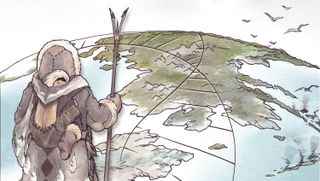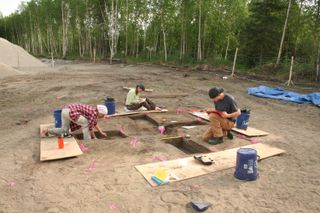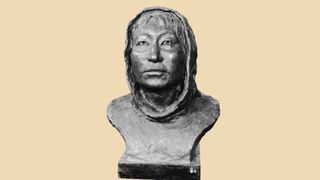These First Americans Vanished Without a Trace — But Hints of Them Linger

There are no surviving members of an ancient and mysterious group of people who lived in North America for millennia. Until now, scientists thought they had vanished without a trace.
But new research shows that this paleo group's genes live on today in several indigenous cultures.
The finding is surprising, as other studies had found that the people — one of the first groups of humans to arrive in North America — made little genetic contribution to later North American people. [10 Things We Learned About the First Americans in 2018]
Using cutting-edge techniques, however, the new research shows that's not the case. "They have never really gone extinct in that way," study senior author Stephan Schiffels, group leader of population genetics at the Max Planck Institute for the Science of Human History in Germany, told Live Science. "They have actually contributed to living people."
The first wave of migrants arrived in North America before 14,500 years ago, likely by crossing the Bering Strait land bridge during the last ice age. But as that ice age ended and glaciers melted, sea levels rose, flooding the land bridge. After that, archaeological evidence suggests that the next major wave of people arrived about 5,000 years ago, likely by boat, Schiffels said. This is the group of people studied in the new research.
People continued arriving in the Americas after that. About 800 years ago, the ancestors of the modern-day Inuit and Yup'ik showed up, and within 100 years, the paleo group from 5,000 years ago had vanished, according to archaeological evidence.
So, what happened to this paleo group? To learn more, Schiffels and his colleagues, including study first author Pavel Flegontov, a faculty member of science in the Department of Biology and Ecology at the University of Ostrava in the Czech Republic, dug knee deep into the genetics of this enigmatic people.
Sign up for the Live Science daily newsletter now
Get the world’s most fascinating discoveries delivered straight to your inbox.

The team received permission from modern indigenous groups to take very small bone samples from the remains of 48 ancient individuals found in the American Arctic and in Siberia. The scientists then ground these bone samples into powder so they could extract and study DNA.
Then, the researchers analyzed the genomes of 93 modern individuals of indigenous heritage from Siberia, Alaska, the Aleutian Islands and Canada. For good measure, the researchers looked at previously published genomes from these regions too.
With the novel method of looking for rare genetic mutations that the paleo group had passed down, as well as other family-tree-modeling methods, the researchers found that the paleo group left a hefty genetic footprint; their genes are found in modern people who speak the Eskimo-Aleut and Na-Dene languages, which includes Athabaskan and Tlingit communities from Alaska, northern Canada, and the U.S. West Coast and Southwest.
The scientists generated so much data that they could build a comprehensive model explaining ancient gene exchange between Siberia and the Americas. This model shows that Na-Dene-speaking peoples, people of the Aleutian Islands, and Yup'ik and Inuit in the Arctic all share ancestry from a single population in Siberia related to the paleo group, the researchers said.
"It is the first study to comprehensively describe all of these populations in one single, coherent model," Schiffels said in a statement.

According to the model, after the paleo group arrived in Alaska between 5,000 and 4,000 years ago, they mixed with people who had a similar ancestry to more-southern Native American peoples. The descendants of these couplings become the ancestors of the Aleutian Islanders and Athabaskans. [25 Grisly Archaeological Discoveries]
Moreover, the ancestors of the Inuit and Yup'ik people didn't just venture from Siberia to North America once; they went back and forth like pingpong balls, crossing the Bering Strait at least three times, the researchers found. First, these ancient people crossed as that original paleo group to Alaska; then, they returned to Chukotka, Siberia; third, they traveled to Alaska again, as bearers of the Thule culture, the predecessor to the modern Inuit and Yup'ik cultures of Alaska, the Arctic, and High Arctic. During their stay in Chukotka — a long stint that lasted more than 1,000 years — the ancestors of the Inuit and Yup'ik mixed with local groups there. The genes from these offspring remain in modern-day people living in Chukchi and Kamchatka, Siberia.
"There's a reason why this was hard [to do] before," Schiffels told Live Science. "These populations are very closely related with each other, and it's very hard to disentangle the different ancestry components."
The study was published online yesterday (June 5) in the journal Nature. In another Nature study published online yesterday, researchers found human teeth dating to 31,000 years ago, remains that are now the oldest direct evidence of humans in Siberia.
- In Photos: Discoveries at the Site of the Pequot War in Connecticut
- Centuries of Tradition: Stunning Photos of Native American Hopi Pottery
- In Photos: Human Skeleton Sheds Light on First Americans
Originally published on Live Science.

Laura is the archaeology and Life's Little Mysteries editor at Live Science. She also reports on general science, including paleontology. Her work has appeared in The New York Times, Scholastic, Popular Science and Spectrum, a site on autism research. She has won multiple awards from the Society of Professional Journalists and the Washington Newspaper Publishers Association for her reporting at a weekly newspaper near Seattle. Laura holds a bachelor's degree in English literature and psychology from Washington University in St. Louis and a master's degree in science writing from NYU.
